Houseplant or potting soil provides insect pests with hiding places for reproduction, food, and protection from enemies. Not only the insect pests reside in the ground, but bacteria, fungi, and nematodes also inhabit and feed on plant roots. Let’s talk about tiny silver bugs houseplant soil.
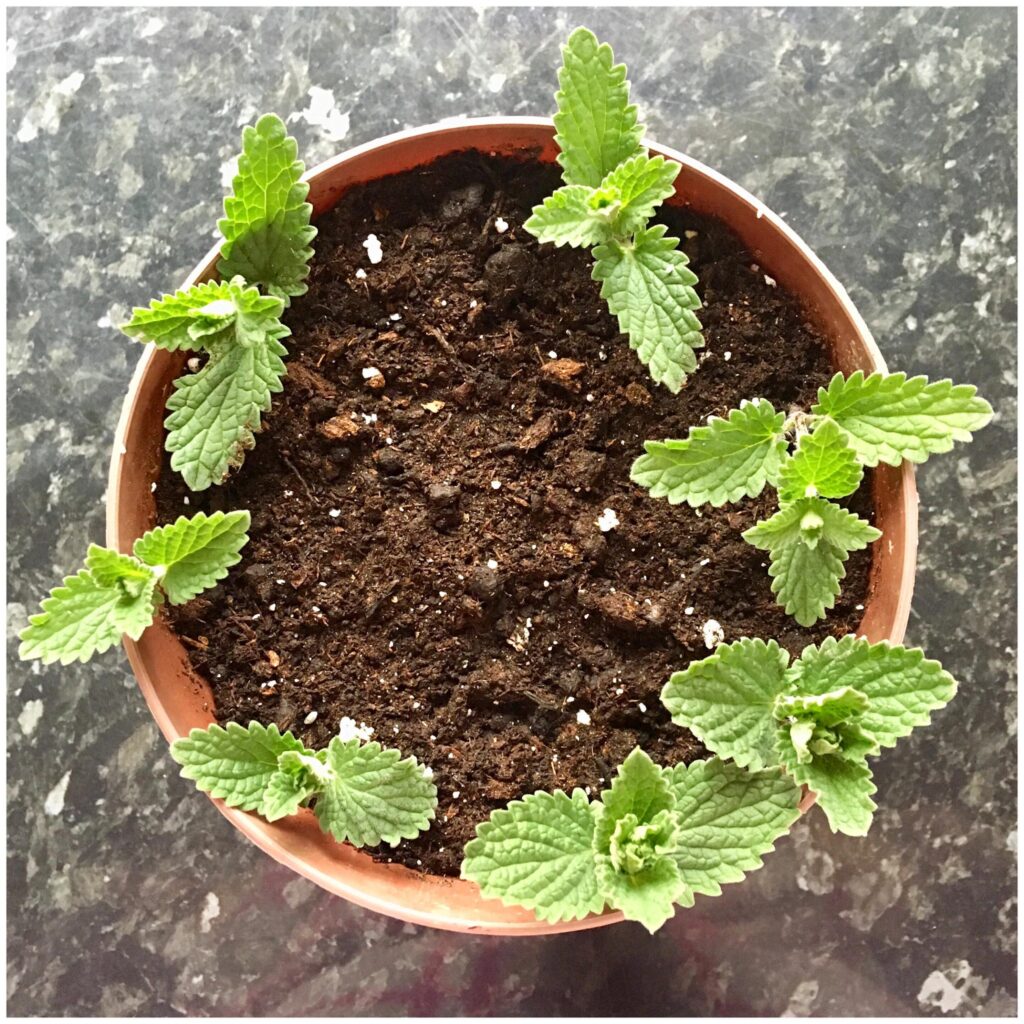
A high-quality potting mix of house plants free from tiny insects
Most of these microbes harm plants and cause root decay and rot, while others help them absorb nutrients. Similarly, some of these bugs in houseplant soil benefit the plant, and others are problematic. The bugs are most likely springtails, mites, whiteflies, thrips, and isopods.
Let’s learn more about these tiny dark silvery bugs in houseplant soil and how to eliminate them when their populations are high.
What Are These Tiny Silver Bugs On Houseplant Soil Surface?
Springtails
Springtails are tiny silver bugs in the potting soil of gardens and indoor plants. They look similar to insects and are silver, gray, or purplish. These little wingless creatures are 1/16 inches in size and are incredibly fast-moving or powerful jumpers.
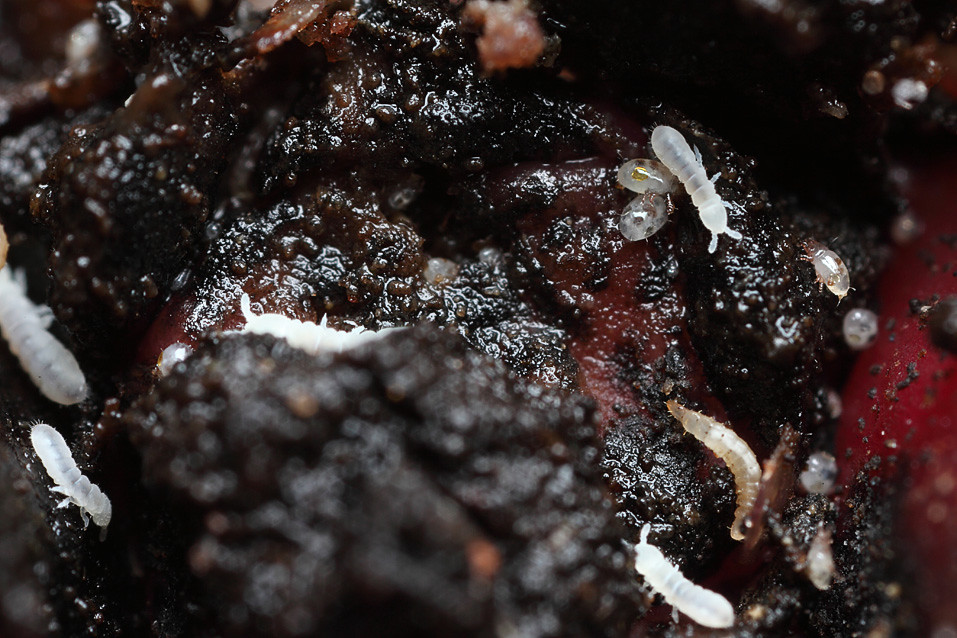
Springtail infestation in garden soil
Springtails inhabit the moist areas of your home outdoors and interior spaces (indoor plant soils). Outdoors, this common silver pest resides in wet soil, decaying straws, rotting leaves, and other damp organic material.
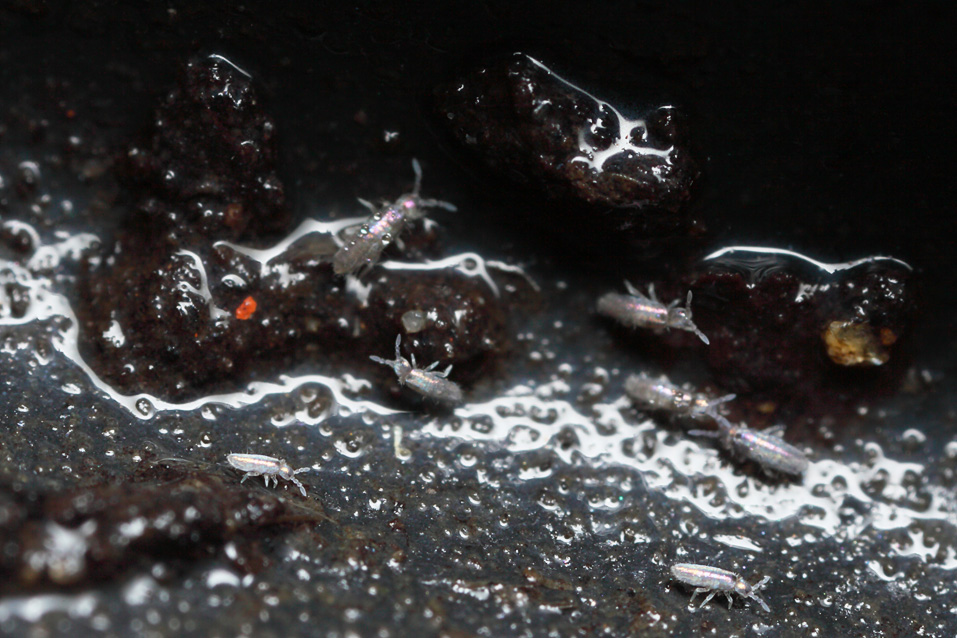
An army of tiny dark silver bugs, along with soil mites, in the compost bin
However, they rarely cause any harm to plants, humans, and pets but love to feed on bacteria, fungi, and organic material while living in the soil. Springtails occasionally damage the house plant’s roots if the soil is overly wet and highly acidic. Their damage appears as small round pits in roots and even death of young seedlings in the case of severe springtail infestations.
Related: How To Get Rid Of Water Bugs In Your Home For Good? The Ultimate Guide
Springtails Control
A few springtails are harmless to your garden and houseplants but need rapid action when their populations are high. These are the most effective ways to kill the higher numbers of springtails;
- Apply neem oil sprays to control the number of springtails on garden-infested plants and indoors. It contains azadirachtin as an active ingredient that works as an antifeedant and insect growth regulator (IGR). Its applications cause springtail death through starvation and disruption in growth.
- Remove the leaf litter, compost bin, and decaying organic material immediately from the garden to keep the springtails and other bugs away.
- For indoor plants, allow the soil to dry out completely between each watering to discourage the infestation of springtails.
- Sprinkle diatomaceous earth on the soil to dry the potting mix and repel the tiny dark silver bugs in the houseplant soil.
- Apply insecticidal soap sprays to kill the springtails and other tiny silver bugs in the soil.
- A well-draining soil is what keeps the roots hydrated and healthy. It also discourages pest infestations by keeping the ground dry. Therefore, mix perlite into the potting mix of your indoor potted plants for good drainage and repel bugs.
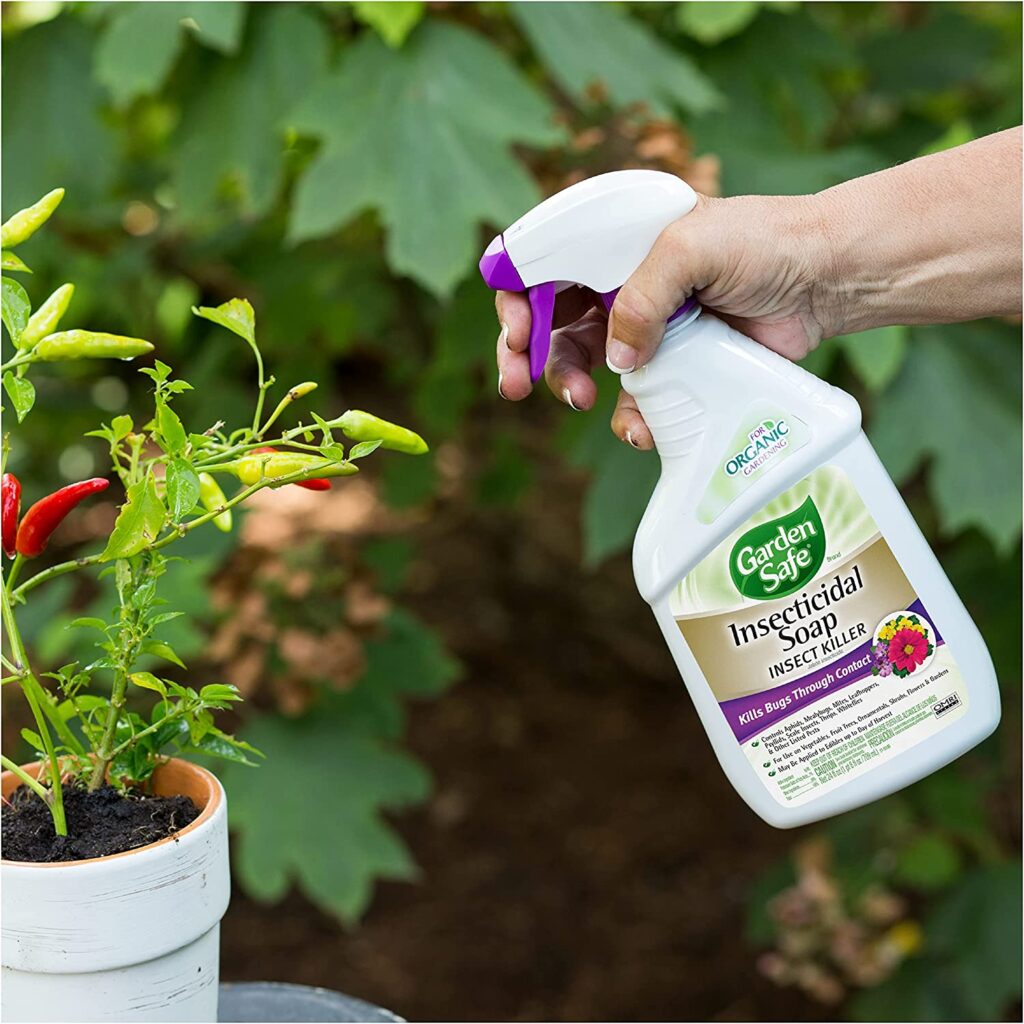
A ready-to-use insecticidal soap spray to keep the pests away and maintain plant health
Isopods
Like springtails, isopods (silver bugs) infest the houseplant soil and gardens and do not cause any damage to plant roots. They feed on leaf litter and prefer to live in moisture-rich soils because isopods breathe through gills. Hence, these silver bugs prefer to infest highly moist soils and can not withstand sun exposure. They appear as brown or silver bugs and are merely 1/8 to 1/2 in size with segmented bodies.
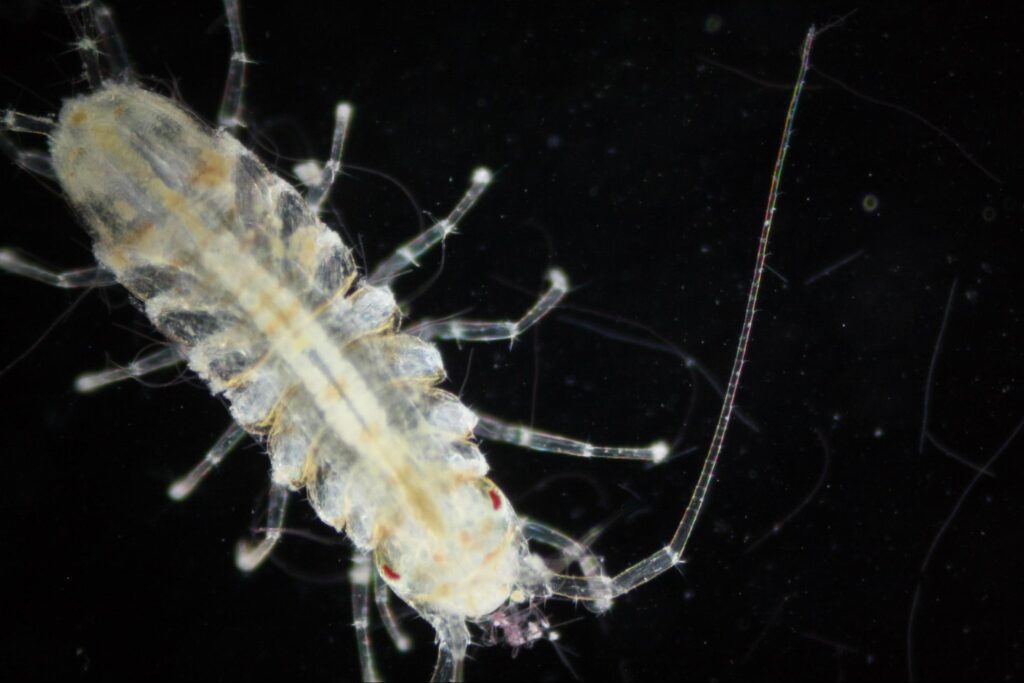
Isopods also infest the houseplant soil and can be problematic or not based on soil dampness and organic matter.
The most common tiny crustaceans visiting houseplants’ soil are sowbugs and pill bugs.
As isopods are harmless to plants but are aware, they start feeding on roots if they have rotted, and may lead to unhealthy plants.
Control Of Isopods
The management of the isopods is similar to the springtails because both infest the overly wet soils and love to feast on organic material. Here are the best approaches to keep these silver bugs away from garden and houseplant soil;
- Avoid overwatering your potted plants, and let the soil dry completely before the next watering.
- Plant your houseplants in pots with enough drainage holes so that excess water drains out quickly and does not create soggy soil conditions.
- Apply soapy water spray to discourage infestations.
- Avoid using organic mulch or black plastic if your vegetable garden has mild isopod infestations. This black plastic as mulch will heat the soils to unbearable temperatures for isopods.
- For your garden and houseplants, devise a proper watering schedule to reduce soil moisture and avoid infestations.
Related: How To Get Rid Of Whiteflies On Houseplants For Good?
Sulfur Plant-based Fungicides
| This fine granular powder is effective against soil mites and other silver bugs in houseplant soil. Bonide Sulfur Plant Fungicide Dust, 4 lbs How to Use Sulfur on Plants? 1. Mix three teaspoons of finely ground sulfur per gallon of water. Pour into a spray bottle and apply on leaves or potting soil to kill the thrips, mites, and other bugs. 2. Apply as a soil drench to boost the root growth while killing the mites. |
Neem Oil
| Neem oil is the most effective insecticide and fungicide against pest prevention in the long run. Safer Brand 5182-6 Neem Oil Concentrate Insecticide, Miticide, Fungicide for Plants soil Benefits of Using Neem oil 1. It protects from mites, fungal pathogens, and insects. 2. Neem oil destroys the outer covering of the insect’s body and causes death due to dehydration. 3. It kills all stages of an insect’s life cycle, ensuring vigorous plant growth. |
Related: How To Get Rid Of Thrips On Houseplants For Good? The Ultimate Guide
Frequently Asked Questions
How Do You Tell The Difference Between A Springtail And A Mite?
Both (springtails and mites) are the most abundant soil dwellers and well-known microarthropods. Springtails are closely related to insects and are the oldest terrestrial animals. They appear as elongated and more rice shaped and are fast-moving. On the other hand, the soil mites are round and slow-moving and appear white or brown. These tiny animals look similar to spiders and thrips. However, with subtle differences in appearance, both springtails and thrips perform the same role—natural recyclers.
They feed on dead insect bodies, decaying organic matter, and other microbial entities. This way, they add nutrients and improve plant-soil interactions.
What Kind of Mites Live in Soil?
Soil mites (Acari) are tiny invertebrates with jointed legs that inhabit the soil and feed on organic matter, fungi, and molds. Some mite types eat garden pests and larvae, and others scavenge on dead insect bodies.
These tiny arthropods act as nature recyclers, eating dead and decomposing organic matter and returning nutrients to the soil so plants absorb these nutrients. These mites appear white or brown, are 1 to 2 mm long, and are as big as the dot of the pencil. Also, these tiny bugs are closely related to spiders and ticks.
Is it Normal to have Bugs in Houseplant Soil?
The most common bugs in your houseplant soil are fungus gnats (also known as soil gnats). These flies infest the ground of your houseplant when it is overly wet and rich in organic matter and humus.
Fungus gnats lay eggs in this moist soil and fly. Their larvae then feed on the soil fungus and roots, damaging the plant’s healthy growth and reproduction. The best way to avoid the infestations of these flies is
- Let the soil dry out entirely between waterings.
- Do not overfertilize the potting soil with synthetic and organic fertilizers.
- Deploy sticky traps around your houseplants to capture the adult flies and interfere with their life cycle.
- Repot your potted plants often to provide new and clean pots and fresh potting mix.
- Make an apple cider vinegar trap to capture the gnat flies
- Dury a garlic clove and raw potato slice inside the infested soil to determine the larvae population.
How Do You Revive a Dying Plant with Hydrogen Peroxide?
Root rot is the main reason for your potted plant’s deteriorating health. The main symptom of root rot is yellow leaves with a dull and papery appearance. If you notice such symptoms in your plants, meaning the root system is rotting.
To prevent further root decay, mix 30 percent hydrogen peroxide solution with 4 liters of water and dip the roots in the solution for six to eight hours. After treatment, replant in a new container with fresh potting mix, water the plant with the same hydrogen peroxide solution, and leave the container in the shade for 1 to 2 days.
How Does Cinnamon Get Rid of Soil Mites?
Cinnamon has antifungal properties and kills the spore germination of most root-rotting fungal pathogens. To get rid of soil mites, combine one tablespoon of cinnamon per four cups of water and let it set for one hour. Then pour the mixture into potting soil. It will destroy the eggs of mites and dissolve the outer covering of nymphs.
Do Soil Mites Crawl on Plants?
Soil mites are slow-moving microarthropods that rarely leave home (potting soil) and crawl on plants. They prefer to live in the ground, feed on dead organic matter, and add nutrients to the earth, improving its texture and nutrition.
How Do You Get Rid of Potting Soil Mites?
These silver bugs rarely damage the potted plant but start feeding on the healthy roots when there is not enough decaying organic matter in the soil. In such conditions to prevent infested plants, these are the best tips;
- Use insecticides such as pyrethrins and pyrethroids to kill soil mites
- Apply hydrogen peroxide solution as a soil drench
- Use natural detergents and soapy water sprays
- Apply homemade garlic and chili dilution to kill the mites and other silver bugs on plants.
Are White Mites Harmful to Plants?
White mites are harmless to hosts and other plants in small numbers but turn enemies of root systems when there is not enough organic matter to eat.
Why are there Small Bugs in my Plant Soil?
These silver bugs in houseplant soil are because of the higher content of leaf litter and compost. They primarily infest grounds rich in organic food sources, so these bugs are harmless to plants in smaller numbers.
How do I Get Rid of Springtail Bugs in my Soil?
Overwatering is the leading cause of the springtails infesting your houseplants’ soil. The best way to get rid of these bugs is to let the potted plant’s soil dry completely before the next watering. Spread diatomaceous earth over the top soil layer to prevent tiny silver bugs in houseplant soil. Also, apply neem oil or hydrogen peroxide dilution as a soil drench to kill these little silver bugs in houseplants.
Sources For Further Reading
- Utah State University. (n.d.). Springtails – School IPM – USU Extension. USU. Retrieved October 14, 2022, from https://extension.usu.edu/pests/schoolipm/structural-pest-id-guide/springtails
- Springtails. (n.d.). Retrieved October 14, 2022, from https://extension.psu.edu/springtails
- Springtails Management Guidelines–UC IPM. (n.d.). Retrieved October 14, 2022, from http://ipm.ucanr.edu/PMG/PESTNOTES/pn74136.html
- Pillbugs and Sowbugs (Land Isopods). (n.d.). Missouri Department of Conservation. Retrieved October 14, 2022, from https://mdc.mo.gov/discover-nature/field-guide/pillbugs-sowbugs-land-isopods
Editor’ Recommendations
Winter Moths: How to Get Rid of These Houseplant Enemies?
Effective Ways To Get Rid Of Russet Mites On Houseplants
What are the Best Practices to Get Rid of Thrips on Houseplants?







